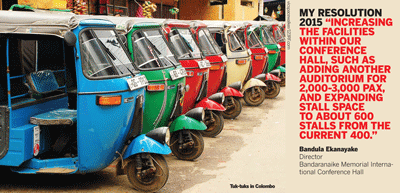 What will the new year bring for the MICE industry in countries across Asia? TTGmice peeks into the future and discovers there is much for most of them to look forward to
What will the new year bring for the MICE industry in countries across Asia? TTGmice peeks into the future and discovers there is much for most of them to look forward to


A more confident China MICE sector
Beijing’s successful hosting of the 2014 Asia-Pacific Economic Cooperation (APEC) meetings in November, and new mega infrastructure projects scheduled to open in Shanghai this year, bode well for the country’s top two MICE destinations.
The goal of industry leaders is to leverage these developments and build on the current “positive” outlook for China’s MICE industry, rolling over into 2016 and beyond.
James Zheng, vice director, Shanghai International Conference Management Organization, said Shanghai is targeting the whole spectrum of the MICE business.
Zheng noted: “The 2015 outlook for MICE in Shanghai is positive for both domestic and international arrivals.
“Shanghai is expecting more tradeshow visitors in 2015 with the opening of the National Exhibition and Convention Center (NECC), and there are already 34 shows on its calendar of events.”
Shanghai welcomed 7.6 million international arrivals in 2013, and there were 5.8 million up to September 2014, a year-on-year increase of 5.5 per cent.
Zheng predicts the soft-opening of NECC last September will benefit all category of hotels, luxury or budget, adding that this year’s opening of Shanghai Disneyland Resort and China’s tallest commercial building, Shanghai Tower, housing J-Hotel, will further add to the city’s MICE allure in 2015 and beyond.
Over in Beijing, Wu Shaoyuan, chief international conference expert, China MICE Service Co, said the hosting of international events such as APEC is a stepping stone for Beijing to further develop its conventions and exhibitions industry.
Wu said: “Beijing didn’t have an international convention centre in the 1980s. After the 1990 Asian Games, the event press centre was turned into the Beijing International Convention Center, and there is now China National Convention Center (CNCC) after the 2008 Beijing Olympics. Hosting APEC has really given us another chance to develop the industry.”
Liu Haiying, CEO of CNCC, said the Concluding Senior Officials Meeting, the Ministerial Meeting, the APEC CEO Summit and the APEC Business Advisory Council Dialogue with Leaders were held at CNCC, the first to provide a one-stop service integrating entertainment, hotel and dining facilities for conventions and exhibitions.
CNCC is now one of the busiest convention centres in Beijing. By end-October 2014, it had hosted 3,918 conventions and events, and 376 exhibitions, with occupancy rate surpassing 80 per cent.
Among conventions and meetings, about 16 per cent were international, and 12 per cent had more than 1,000 participants.
Unlike commercial events, Liu added high-level events, especially political meetings, tend to see changes all the time, placing a lot of challenges on operating the convention centre.
Having had to deal with many unexpected situations during APEC, CNCC is now truly tried and tested, he said.
I predict…
 Business travel and corporate events will hold (steady) or increase because China is still developing and the economy is strong.
Business travel and corporate events will hold (steady) or increase because China is still developing and the economy is strong.
Some convention centres in Beijing have reported slow business in 2015, but it’s a different story in Shanghai, which has won a number of international association conferences this year.
Liu Ping
CEO, China Star
Shanghai and Beijing will remain the top two destinations, according to the inquiries we have received for incentives and events in China in 2015.
About 60 per cent of the requested proposals are for Shanghai, 43 per cent for Beijing, and 22 per cent for both Beijing and Shanghai.
Michael Chang
Director, corporate meetings & events, Destination Asia (China)
Clawing its way back
![]()
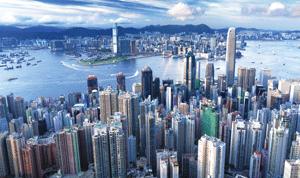
Despite disruptions by the Occupy Central movement in Hong Kong that ended last December, the industry’s outlook for MICE in 2015 remains optimistic but prudently so. While at press time the Hong Kong Tourism Board (HKTB) is not ready to share its 2015-16 MICE strategy, the trade hopes to see more proactive measures from the NTO in regaining meeting planners’ confidence to hold events in the city.
InterContinental Hong Kong is looking to grow its overall MICE contribution throughout 2015. Director of sales and marketing, Linda Hodgson, pointed out MICE remains an important segment for the hotel.
“For our hotel, the MICE segment is of value seven days a week, 12 months of the year in terms of guestroom impact, event space impact and F&B contribution. The US MICE market is a key focus, a source of incoming meetings and incentive programmes. Planners and attendees find Hong Kong a welcoming world city where English is spoken widely. Other key MICE markets for our hotel include Australia, Singapore, the UK and Europe.
“Additionally, Hong Kong is regarded as one of the safest cities in the world, and visitors can stay between seven and 180 days without any visa application hassles. The Hong Kong dollar is also pegged to the USD, making the (currency) exchange and planning easier for PCOs.”
However, The Destination Management Company managing director, Jenny May, has doubts about any increase in MICE business for 2015.
“The negative international media coverage on the Occupy Central protests hasn’t helped. The Hong Kong hotels are hurting too and have come up with some special rates and offers for 2015. We will inform our clients in the main markets of New Zealand, Australia, South Africa and the UK about this and see if it can generate some business with short lead times. This could result in some last-minute smaller groups.”
Meanwhile, the Hong Kong Convention and Exhibition Centre (HKCEC), which completed its second expansion in 2009, has reached the maximum capacity of its purpose-built 66,000m2 exhibition space, especially during the peak seasons.
Some other key venues in the city are also expected to achieve that scale within the next few years.
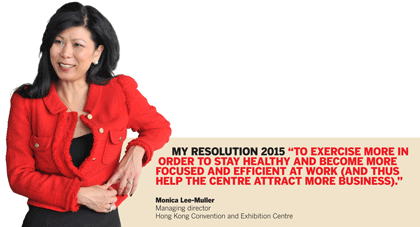 HKCEC managing director, Monica Lee-Muller, confirmed: “The use of space is expected to remain high due to recurrent exhibitions and growth in new business.”
HKCEC managing director, Monica Lee-Muller, confirmed: “The use of space is expected to remain high due to recurrent exhibitions and growth in new business.”
She pointed out: “Hong Kong needs more exhibition space downtown, or the development of its convention and exhibition industry will be constrained, losing out to neighbouring cities.”
“Hong Kong should continue to focus on international exhibitions given their recurrent nature and significant economic contribution. The next focus should be international conferences.”
I predict…
 2015 will be a very poor year for Hong Kong’s MICE business unless we can attract some small groups with short lead times. The hotels are lowering their rates and their special offers are helping with this.
2015 will be a very poor year for Hong Kong’s MICE business unless we can attract some small groups with short lead times. The hotels are lowering their rates and their special offers are helping with this.
Our reps are organising roadshows and sales calls in their respective countries, which we will take part in. We will spread the message that Hong Kong is still exciting, affordable and a must-visit destination. Nowhere else in Asia does a city have as much to offer as Hong Kong, and our clients need to be reminded of this.
Hotel rates will continue to rise but not too aggressively, given the impact of the Occupy Central incident. The business outlook is not as good as 2016 based on what we have observed.
Katerina Tam
Director, International Conference Consultants
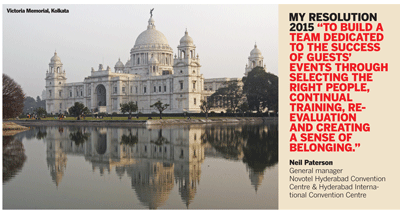
India expects boom in conferences

With a new government elected in India last year which announced and implemented measures like the launch of the e-visa scheme for nationals of 43 countries, there is a positive mood across the sector.
Said Swadesh Kumar, vice chairman, India Convention and Promotion Bureau (ICPB): “Overall, the outlook of inbound MICE arrivals in India has been getting better over the years. The sector is expected to grow eight to 10 per cent in 2015.
“India’s economy is doing better and the untoward incidents related to the safety of women tourists are way behind us. The new government is also taking proactive steps for the growth of the industry and safety of foreign tourists.
”The conference segment is expected to lead the growth of the MICE market.
“Europe has been one of our key source markets. But with industries there struggling, there are chances that incentive travel may take a back seat. However, the conference market will grow as companies are keen to come to India to explore business opportunities here,” said Kumar.
He added that apart from the traditional markets, MICE movements are expected to grow from Latin America and East European countries like Slovenia, Czech Republic, Hungary and Poland, which have now begun to show interest in India.
After much dilly-dallying, ICPB is expected to organise its convention in April in Delhi NCR region.
“With the general elections taking place in India last year, we were unable to organise the convention. However, this year we are going ahead with the convention where our prime focus would be to convince office bearers of local associations to aggressively bid for the international conference business.
“Considering that 90 per cent of the international conference business come to India due to local associations, it is the need of the hour,” said Kumar.
ICPB is also planning to conduct roadshows in international markets including Munich, Paris and Geneva in the first half of this year to showcase India as a MICE destination. ICPB also expects to launch a report this year that will highlight what steps are needed to grow the inbound MICE market in India.
India at present does not have a mechanism to count MICE arrivals in the country and there is no marketing budget assigned especially for MICE. However, the Ministry of Tourism reimburses companies which travel overseas to bid for a conference.
I predict…
 Apart from key markets like the US, the UK and Europe, I see the emergence of newer markets such as Latin America, China, South Korea and the Far East.For the coming inbound season, our internal research and analysis team has revealed that the number of tourists from China to India can be anticipated to increase by approximately 20 per cent.
Apart from key markets like the US, the UK and Europe, I see the emergence of newer markets such as Latin America, China, South Korea and the Far East.For the coming inbound season, our internal research and analysis team has revealed that the number of tourists from China to India can be anticipated to increase by approximately 20 per cent.
Prashant Narayan
COO and head, leisure travel inbound business, Thomas Cook India
 Indian cities like New Delhi, Mumbai and Hyderabad have been attracting a major share of international MICE movements.
Indian cities like New Delhi, Mumbai and Hyderabad have been attracting a major share of international MICE movements.
But with the government elected last year looking to develop infrastructure and fuel industry growth across the country, other cities will also get their share of the market.
Chander Mansharamani
Managiing director, Alpcord Network Travel & Conferences
Indonesians keep positive stance

Indonesia’s MICE industry can expect a positive business climate this year, thanks to its growing economy and despite the new government’s policy to watch costs.
At the Indonesia MICE Outlook seminar in Jakarta in December, Indonesian economist Aviliani said: “The Indonesian economy is projected to grow 5.2 to 5.6 per cent in 2015. This growth rate will propel Indonesia to the top three in the world, after China and India.”
The consumption sector will still dominate with 57 per cent of GDP, while the investment sector will contribute 10 per cent and export/import, 15 per cent.
Aviliani also projected the telecommunications, financial, property and infrastructure sectors would continue to grow.
“The government puts a strong emphasis on the development of infrastructure with the national budget doubling to 400 trillion (US$16.7 billion) from 200 trillion rupiah. This means that businesses related to infrastructure development, like cement and steel, will grow,” she said, adding that these sectors provide growth opportunities for the MICE industry.

However, the new Indonesian government has decreed that officials will have to fly economy class for business travel and has banned the public sector from having meetings outside government premises. This will have an impact on MICE-related businesses.
“Many hotels (in the various regions) have been built to cater for the (growing) demand of government meetings (in line with regional autonomy). If the policy is not revised, these hotels will suffer, putting pressure on the Indonesian economy,” she said.
Under President Joko Widodo, who took office last October, the tourism authority has been elevated to a full-fledged Ministry of Tourism. As of December, the structure of the new ministry was still in the making.
Rizki Handayani, the ministry’s director of MICE and special interest tourism marketing, said: “We are yet to see where the MICE authority will be positioned, but the existing plan for 2015 will see (the Ministry of Tourism) networking with other government offices like the Ministry of Trade and Ministry of Industrial Affairs to foster events, especially exhibitions.”
For the first time, the ministry will focus on exhibition promotions and will work closely with the Indonesia Exhibition Companies Association, revealed Rizki. She said there are now 14 international exhibition players with offices in Indonesia, and the country needs to optimise this to attract B2B exhibitions in Jakarta and other parts of Indonesia.
“We will also try to encourage regional tourism offices, many of which now have tourism promotion bodies, to join the ministry in tradeshows and roadshows to promote their destinations,” she said.
I predict…
 There will be more corporate and incentive travel in Indonesia, especially in Bali, as domestic and international companies try to boost sales with training for staff and travel in regional Indonesia or overseas.
There will be more corporate and incentive travel in Indonesia, especially in Bali, as domestic and international companies try to boost sales with training for staff and travel in regional Indonesia or overseas.
The Indonesian government will also be more selective in financing international events as part of its efforts to utilise the budget more effectively and efficiently.
Ketut Jaman
Managing director, Melali MICE Bali
 Strong growth for the Indonesian MICE industry, since the country has various MICE destinations which are also value-for-money for international delegates.
Strong growth for the Indonesian MICE industry, since the country has various MICE destinations which are also value-for-money for international delegates.
The biggest trend will be an increasing number of international B2B meetings and exhibitions taking place in Indonesia, driven by improving global economic conditions.
Also, in line with our new government’s focus, meetings and exhibitions in the infrastructure, maritime, food and energy sectors will dominate. As of now, we have confirmed four international events in 2015 including conferences and exhibitions, two to be held in Jakarta and two in Bali.
Susilowani Daud
President director, Pacto Convex
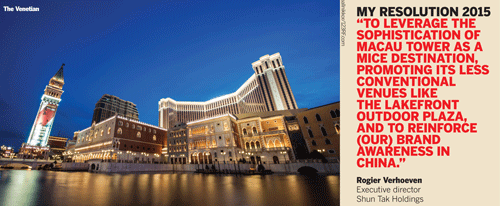
New products bring excitement

With new hotels set to open and expansion projects planned for existing integrated resorts like The Parisian and Galaxy Macau, 2015 will be an eventful year for Macau, with much to excite MICE visitors.
MCI Macau’s managing director, Peter Hassall, believed the world will take further notice of Macau as the second wave of properties open.
Venetian Macau’s vice president of sales and resort marketing, Brendon Elliott, said in 2015 it is “extremely important” for Macau to move towards becoming a final destination with multiple offerings, instead of a stopover for tourists within the region.
MICE is the second most fundamental part of Venetian Macau’s operations. The property has enjoyed good growth in international meetings from farther abroad, such as the US, Europe and Australia, he said.
“The strength of these markets in 2015, 2016 and beyond looks positive. In order for us to get ahead in the competitive global MICE industry, we need to first promote Macau as a cultural and heritage destination rather than primarily on our established infrastructure and entertainment,” said Elliott.
“We have a significant rise in the number of MICE groups in 2016-2019. Growth in the industry will continue as new infrastructure projects open, like the Guangzhou-Zhuhai high-speed railway, the redevelopment of the Taipa ferry terminal and the final section of Hong Kong International Airport-Zhuhai-Macao Bridge.”
The Macau Government Tourist Office (MGTO) said it intends to continue to leverage the support of its representatives in Asia, Europe and North America – including a new representative office in India that came on board in January – to promote the city for incentive programmes.
MGTO director, Maria Helena de Senna Fernandes, said: “We will continue to show incentive planners the city’s convenience as an incentive destination, given the integrated nature of the new tourism complexes and the diversity of our products.
“Our agenda this year for attracting more incentive events includes travel shows in Australia, China, Germany, Thailand and the US, as well as the promotion of our Incentive Travel Stimulation Program.”
Overall, the mood is upbeat, with players preparing themselves to harness opportunities. MCI, for example, is embracing a “three Ps” approach in 2015, namely partnering, performance and preparation.
Said Hassall: “We aim to build stronger relationships with our existing clients and the venues we work closely with; we want to bring new clients to Macau; and we want to form new partnerships with new Macau properties. We aim to ensure every event we produce will inspire and engage our clients’ audiences.”
I predict…
 The biggest trend in 2015 is that of companies striving towards greater connection with customers.
The biggest trend in 2015 is that of companies striving towards greater connection with customers.
Our clients are seeking meaningful connection with their customers and audiences, and the live, face-to-face communication solutions we provide will need to be outstanding in order to achieve the desired audience response, behaviour or emotion.
Events do not stand alone; they are connected to an integrated marketing strategy. Successful events will have close links with digital, social and other communication and marketing initiatives.
Peter Hassall
Managing director, MCI Macau
 I predict the lowering of rates and better concessions from major integrated resorts due to additional meeting space and 5,000 hotel rooms.
I predict the lowering of rates and better concessions from major integrated resorts due to additional meeting space and 5,000 hotel rooms.
Organisers of mega events will also look at Macau for its two new auditoriums – one at Galaxy Macau and another at Studio City – for 2,000-3,000 people each.
Bruno Simoes
Executive director, smallWorld Experience
Leveraging festivals year for MICE

The Malaysia Convention & Exhibition Bureau’s (MyCEB) goals are to make Malaysia one of the top five Asia-Pacific destinations for international conventions, and to attract 2.9 million business event visitors – eight per cent of overall tourist arrivals – by 2020.
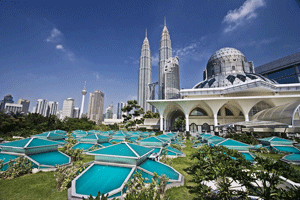
In 2013, Malaysia attracted some 1.4 million business events arrivals, which translated to 5.2 per cent of total tourist arrivals to Malaysia.
This year, MyCEB will leverage the events held during the year-long tourism campaign, Malaysia Year of Festivals 2015 (MyFEST 2015), to attract more corporate and incentive groups to Malaysia, supporting the national campaign with special value-adds for business events visitors, according to Ho Yoke Ping, general manager – business events at MyCEB.
MyFEST campaign has a line-up of more than 200 events comprising cultural festivals, arts and music showcases, food promotions, shopping and sports activities.
Ho added MyCEB also plans to introduce a digital campaign for the corporate and incentive segment, targeted for launch in the first quarter.
“MyCEB will continue to focus on its current market mix – Europe, North America and Asia-Pacific – for the convention business, and mainly Asia-Pacific for corporate meetings and incentives,” said Ho.
Conventions have always been the bureau’s key focus and comprise around 60 per cent of the business mix. Corporate meetings and incentives are also important due to their large numbers, and short- to medium-term lead time.
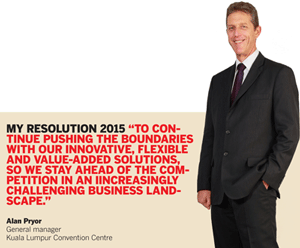 Last year, MyCEB started to target the trade exhibition market and managed to secure three trade exhibitions which will be held in Malaysia this year. They are Café Malaysia 2015; Café Show Malaysia 2015 and Cityscape Malaysia. The three shows combined are expected to attract some 3,720 international visitors to Malaysia this year.
Last year, MyCEB started to target the trade exhibition market and managed to secure three trade exhibitions which will be held in Malaysia this year. They are Café Malaysia 2015; Café Show Malaysia 2015 and Cityscape Malaysia. The three shows combined are expected to attract some 3,720 international visitors to Malaysia this year.
The bureau will organise another Malaysia Business Events Week this year (the date and venue of which were not finalised as at press time), aimed at expanding the capability and creativity of Malaysia’s business events industry players.
MyCEB organised the inaugural Malaysia Business Events Week in Kuala Lumpur last year to create a platform for local business events players to gather and discuss ideas that impact the growth and sustainability of the meetings industry.
I predict…
 More MICE planners will be looking at sea cruises around Asia as an incentive option. The incentive holiday starts from the moment passengers get on board, and they are entertained throughout. Cruise ship providers are also flexible with their offerings for big groups.
More MICE planners will be looking at sea cruises around Asia as an incentive option. The incentive holiday starts from the moment passengers get on board, and they are entertained throughout. Cruise ship providers are also flexible with their offerings for big groups.
Saini Vermeulen
Head, international sales, Panorama Tours
 Local companies budgeting for participation in meetings and exhibitions, and sponsorship budgets being put on hold until the stabilisation of the Goods and Services Tax (to be implemented on April 1). Companies would rather spend time ensuring implementation processes are correct than on business development.
Local companies budgeting for participation in meetings and exhibitions, and sponsorship budgets being put on hold until the stabilisation of the Goods and Services Tax (to be implemented on April 1). Companies would rather spend time ensuring implementation processes are correct than on business development.
Anthony Wong
Managing director, AOS Conventions & Events
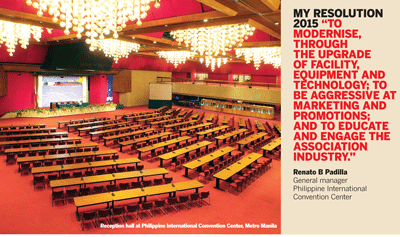
Ensuring fun works for meetings
![]()
While the Philippines’ major MICE market has always been Asia-Pacific, the country is broadening its goal to include Europe and the US this year.
Domingo Ramon Enerio III, COO of the Tourism Promotions Board (TPB), said: “We will definitely be intensifying our campaign in our major European markets” following the lifting of the ban on Philippine carriers in early 2014 by the European Union.
“These European markets include the UK, Germany, France, Italy, Switzerland and Austria.“We will also be looking towards expanding our campaign in North America, following the upgrade of the Philippines to Category 1 status by the US Federal Aviation Administration.”
The big-picture goal for the Philippines is to draw 8.2 million foreign tourists to the country in 2015 – or 64 per cent higher than the five million targeted in 2014.
TPB is confident the huge increase is achievable through two banner campaigns – Visit Philippines 2015 and the MICE branding Fun Works.
Just how much of the arrivals target in 2015 is MICE is not known. But undoubtedly, there is also going to be a huge leap in MICE arrivals from the slew of scheduled international MICE events, including the series of over 150 Asia Pacific Economic Cooperation (APEC) meetings throughout the year.
“We regret that we don’t have information on Philippine MICE arrivals and spending in general,” said Enerio.He added the main focus of this year’s MICE campaign, Fun Works, is primarily on international association meetings, followed by corporate meetings, then incentive groups.
Fun Works is connected to the destination’s branding, It’s More Fun in the Philippines, alluding to being more productive at work when one is happy and having fun.
Enerio said that in anticipation of the forthcoming ASEAN integration, “we will be focusing our efforts on areas that would ensure our preparedness and competitiveness in receiving business events visitors as well as leisure travellers”.
These areas include enhanced connectivity, accessibility, airport and seaport infrastructure and quality of the destination’s tourism offerings.
I predict…
 Video is the next text (SMS). Events and exhibitions will be portrayed as an experience rather than a mere display of products and events, leaving an impact on the community. There will be also more cooperation, subventions and focus on research.
Video is the next text (SMS). Events and exhibitions will be portrayed as an experience rather than a mere display of products and events, leaving an impact on the community. There will be also more cooperation, subventions and focus on research.
Asia is the region to watch. There will be more mergers and acquisitions of events, with foreign organisers increasingly looking to buying shows and setting up branch offices in other countries.
China will be the major player in Asia with more shows being organised and more exhibition centres in major cities being built.
Marisa D Nallana
President, Philippine Exhibits and Theme Parks Corp
Corporate and medium-sized meetings with 100 to 300 pax will be held mostly in hotels – one-stop shops where meeting packages, accommodation and everything else are well-provided for.
Bigger-sized meetings and international conferences will go to convention centres like SMX Convention Center and Philippine International Convention Center.
Carla Mariano
Manager, groups, MICE and special projects, Blue Horizons Travel & Tours
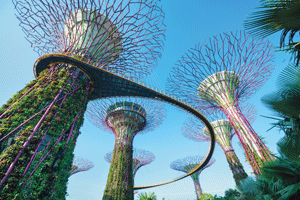
Five-year game plan commences

The Singapore MICE sector continues to remain in a “position of strength”, the Singapore Tourism Board (STB) believes, and the tourism authority aims to further strengthen the leadership position by “pushing new frontiers”, said Neeta Lachmandas, assistant chief executive of STB.
A five-year MICE 2020 plan is being rolled out to ensure that Singapore is better positioned to deal with industry challenges and further elevate its value proposition.
The plan will begin its first phase with the STB looking at enhancing the MICE industry’s “experience creation capabilities”, and developing Singapore into a hi-tech destination as well as Asia’s MICE resource capital with skilled talent and knowledge.
 Lachmandas added: “We will also continue to focus on developing and attracting events’ content premised on value-creation, as well as driving the growth of a vibrant business events landscape.”
Lachmandas added: “We will also continue to focus on developing and attracting events’ content premised on value-creation, as well as driving the growth of a vibrant business events landscape.”
To develop Singapore into a “smarter” MICE city under the MICE 2020 plan, STB will, for example, look at incorporating seamless Wi-Fi connectivity in major MICE venues.
Of the 15.6 million Singapore visitor arrivals in 2013, 3.5 million were business and MICE visitors, who contributed S$5.5 billion (US$4.2 billion) of the S$23.5 billion in total tourism receipts. However, at press time, STB is unable to provide projected figures for this year.
While the Asia-Pacific region will remain Singapore’s main MICE source market, with all segments of the MICE industry being critical for Singapore, Lachmandas said STB will be looking at attracting more business events from Europe and the US.
I predict…
 A stronger focus on the development and protection of intellectual property in the MICE industry due to greater industry maturity, and as a response to greater industry competition due to MICE firms large and small widening service offerings to deal with demand gaps in traditional business areas.
A stronger focus on the development and protection of intellectual property in the MICE industry due to greater industry maturity, and as a response to greater industry competition due to MICE firms large and small widening service offerings to deal with demand gaps in traditional business areas.
Daniel Chua
Managing director, Aonia
 A very positive outlook for the MICE industry in Singapore. Because as Singapore continues to reinvent itself with the growing number of hotels, attractions and unique MICE venues like Gardens by the Bay, the country continues to increase its offerings of breath-taking experiences.
A very positive outlook for the MICE industry in Singapore. Because as Singapore continues to reinvent itself with the growing number of hotels, attractions and unique MICE venues like Gardens by the Bay, the country continues to increase its offerings of breath-taking experiences.
Alex Yip
Executive director, Vacation Singapore DMC
Hopes pinned on first-ever MICE Travel Mart

Having had a successful year in 2014 attracting small conferences and meetings, Sri Lanka aims to expand this segment in 2015, starting the ball rolling with a travel mart for regional incentive and conference planners.
According to Vipula Wanigasekera, general manager of Sri Lanka Convention Bureau (SLCB), a MICE Travel Mart – the first ever here – will be held in February or March where 50 to 100 incentive and conference planners from India, Pakistan, Bangladesh, Singapore, Malaysia, Indonesia and Vietnam will be hosted with pre-paid airfares and free hotel accommodation.
“We want to show this group – the most important in the MICE industry – the diversity of our offerings, ranging from city hotels to the green environment,” he said.The number of conferences in 2014 rose to 62, from 42 in 2013. A 10 to 20 per cent increase is forecast for this year.
Another initiative that is greatly anticipated for this year is a campaign roping in representatives of 200 government organisations to attend conferences abroad to promote the country as a conference destination, with a special push for Colombo.
“We met the heads and senior officials of these state organisations and impressed upon them the need to promote Sri Lanka through the conference circuit,” he said.
In January, SLCB launched a mega promotion campaign in several Indian cities, including Mumbai and New Delhi, to promote meetings and incentive travel to Sri Lanka.
Lanka Exhibition & Conference Services general manager, Aasim Mukthar, said there has been a drop in Indian incentive visitors due to high hotel rates. For instance, five-star rooms in Colombo command a minimum of US$170 per night compared to US$100 or lower in Malaysia or Thailand.
“Indians also find it boring outside (their hotels in) Colombo as there is not much nightlife or after-dark entertainment,” Mukthar added.
However, SLCB’s Wanigasekera said while 50 per cent of the Indian incentive market may look for cheaper options, the rest is willing to pay for a unique product and this is where Sri Lanka stands out, he believed.“Our diversity is unmatched and we are essentially one of the few green destinations still around,” he explained.
I predict…
 An increase in the number of Chinese companies participating in local trade fairs and exhibitions. There was an increase in 2014 and we see this growing in the next few years, particularly since China is due to enter into a Free Trade Agreement (FTA) with Sri Lanka.
An increase in the number of Chinese companies participating in local trade fairs and exhibitions. There was an increase in 2014 and we see this growing in the next few years, particularly since China is due to enter into a Free Trade Agreement (FTA) with Sri Lanka.
Chinese companies view participating in local trade fairs as a window to the Sri Lankan market and sales of their products. The proposed FTA will be a huge facilitation.
Aasim Mukthar
General manager, Lanka Exhibition & Conference service
 We are excited by the major promotional campaigns planned by the Sri Lanka Conventions Bureau (SLCB) through the MICE Travel Mart and also a campaign encouraging hundreds of government representatives attending overseas conferences to make a bid to host the next meeting in Sri Lanka.
We are excited by the major promotional campaigns planned by the Sri Lanka Conventions Bureau (SLCB) through the MICE Travel Mart and also a campaign encouraging hundreds of government representatives attending overseas conferences to make a bid to host the next meeting in Sri Lanka.
These are challenging initiatives and we are fully backing SLCB in this endeavour and its many promotions that would take place in India next year.
Zian Ameen
General manager, Aitken Spence Exhibitions and Conventions, and president, Sri Lanka Professional Conference, Exhibition and Events Organizers
Thailand expects growth to return
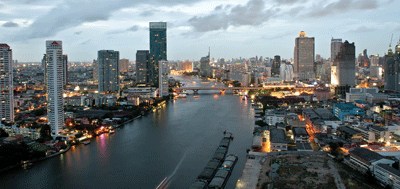

Thailand’s MICE industry was hit hard by the country’s political crisis last year, but the national convention bureau is confident the market will return to growth in 2015.
Nopparat Maythaveekulcha, president of Thailand Convention & Exhibition Bureau (TCEB), said Thailand is targeting 1,036,300 MICE visitors with total spending of 106.8 billion baht (US$3.6 billion), up 17 per cent and 22 per cent respectively on last year’s targets.
“TCEB has developed the Thailand Connects the World: Global Businesses and Local Experts Link to Boost Business Events Success brand communications campaign, which builds on last year’s campaign.
“It targets top quality buyers and business events visitors from around the world, and will showcase three fundamental pillars of Thailand’s MICE industry, including Destinations of Thailand, Business in Thailand, and People of Thailand,” he explained.
The bureau’s targets by market segment are: meetings, 255,000 visitors with spending of 32.7 billion baht; incentives 252,800 and 19.2 billion baht; conventions 333,100 and 37.8 billion baht; and exhibitions, 190,400 and 17 billion baht.
 To support its goals for meetings, incentives and conventions, TCEB has developed a Win, Promote and Develop strategy. Win focuses on generating demand, bidding for mega events, developing promotions and strengthening sales and marketing by expanding the network of overseas representative. Promote will see TCEB raise Thailand’s profile at key trade events and roadshows, while Develop involves increasing the capacity and skills of local MICE businesses and venue operators.
To support its goals for meetings, incentives and conventions, TCEB has developed a Win, Promote and Develop strategy. Win focuses on generating demand, bidding for mega events, developing promotions and strengthening sales and marketing by expanding the network of overseas representative. Promote will see TCEB raise Thailand’s profile at key trade events and roadshows, while Develop involves increasing the capacity and skills of local MICE businesses and venue operators.
For exhibitions, Nopparat said TCEB will focus on increasing the number of attendees at shows rather than trying to attract more new events. Regional collaboration will also be key.
“TCEB will work closely with strategic counterparts in ASEAN and beyond, in line with the Regional Comprehensive Economic Partnership, which will formalise a free trade agreement among the 10 ASEAN member states plus Japan, South Korea and China,” he said.
I predict…
Green awareness and innovation will become more important for conferences. Besides social media, custom applications will be used as communication tools. As information is so easy to access online, the conference topic is very crucial and it must be very specific and interesting. International standards of conference management and the need for organisers to be certified will be more important (especially for the green or environmental aspects of an event).
Perapan Anghasuko
Head, NCC Management & Development
Corporate meetings tiptoe back
Corporate meetings and events across Asia-Pacific are expected to get back into the game this year, albeit with some prudence, reports Paige Lee Pei Qi
In 2015, meeting budgets are likely to register growth or a smaller decline than was seen previously.
Issa Jouaneh, vice president and general manager, AMEX Meetings & Events, said: “The last few years have given focus to meetings and events in a way that has driven a more disciplined approach around approval processes, increased scrutiny on spend, and a larger focus around accountability and expected outcomes for meetings.
“In many organisations, budget pressure exists, but people are still holding meetings where there is a clear need and purpose.”
Similarly, Advito, the consulting arm of BCD Travel, revealed in its corporate travel price forecast for 2015 that companies will want to travel more as economic conditions continue to improve.
However, the report highlighted businesses “will remain cautious about spending too much too soon, so travel growth will be modest rather than spectacular”.
Corporates are unlikely to find savings with the hotels, as rates across Asia this year are predicted to increase between one and four per cent, as “growth in demand and supply will be well-matched”, the report added.
Likewise, Carlson Wagonlit Travel (CWT) Meetings & Events and Global Business Travel Association (GBTA) alerted corporate travel buyers to higher hotel prices in its joint Global Travel Price Outlook report 2015.
According to the report, hotel suppliers will be in a “better negotiating position than they have been for some time” in 2015. This improved outlook could lead to greater pressure on negotiated rates for travel managers and buyers, and in Asia-Pacific, hotel prices are expected to grow 2.7 per cent this year.
Joseph Bates, GBTA Foundation vice president of research, said most travel procurement managers are already bracing for the forecast single-digit increases in not just hotel, but also air and ground pricing.
But Bates urged travel managers to consider “contingencies” in their forecast including the escalating Ukrainian crisis, declining European inflation, burgeoning debt in China and oil price shocks, all of which could potentially have a negative influence on travel demand and pricing.
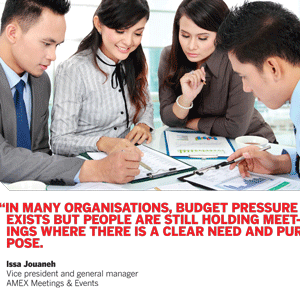 AMEX predicts air costs to rise two per cent this year, up from the predicted 1.6 per cent for 2014, due to slightly higher demand and airlines’ tight management of capacity.
AMEX predicts air costs to rise two per cent this year, up from the predicted 1.6 per cent for 2014, due to slightly higher demand and airlines’ tight management of capacity.
With business travel prices on the rise, effective budgeting is therefore key. Options that businesses are exploring to control overall cost include reducing the length of the event, and cutting down on unnecessary frills, according to Advito.
A travel manager of an MNC suggested: “We can look at other more cost-effective destinations to control our budget. Instead of holding meetings and incentives in high-demand locations, we could take staff to emerging destinations like Sri Lanka.”
George Yeo, Magenta Consulting Services’ business development manager, shared: “We are increasingly using more four- and even three-star properties, which can help reduce costs by at least 10 to 20 per cent. These properties are pretty impressive these days and as long as they have the adequate meeting facilities we need, our clients will be agreeable to using them.”
AMEX’s Jouaneh affirmed: “Meeting planners, particularly those seeking high-demand locations for their meetings, will likely feel the additional pressure on their meeting budgets so – for the third year in a row – we expect a rise in demand for mid-tier properties across the globe.”
Additionally, the role of technology will continue to rise in importance, Jouaneh pointed out.
“Planners across all regions are predicting virtual will be a part of at least 10 per cent of their meetings this year. The evolution and sophistication of technology appears to be making it easier to use, leading to more serious consideration around implementing virtual or hybrid meetings today, whereas in past years the discussions were much more theoretical,” he said.
Changing exhibitions landscape
The opening of Asia’s largest exhibition centre in Shanghai is set to change the stakes for that market, predicts Mark Cochrane. He also tips that aside from China, South-east Asia remains a market to watch
2015 promises to be a dynamic year for exhibitions in Asia. There are plenty of significant changes playing out in key markets across the region, the most crucial of which is in China, with the opening of the new mega venue in Shanghai.
The National Centre for Exhibition & Convention (NCEC) will add an incredible 400,000m2 of indoor space to the market in Shanghai, making it the largest exhibition venue in Asia and one of the world’s largest. The venue will also feature 100,000m2 of outdoor space and a wide range of support facilities including hotels, restaurants, and office and residential developments. Nearby, there is an airport and a high-speed rail terminal.
NCEC will offer strong competition for Shanghai’s other venues, particularly the Shanghai New International Expo Centre which features about 200,000m2 of indoor space and 100,000m2 of outdoor space. NCEC is 60 per cent owned by the China Foreign Trade Group (organiser of the massive Canton Fair) and 40 per cent by state-owned Shanghai EastBest International Company.
Consequently, how NCEC is managed will play a key role in shaping the future of the exhibition industry in Shanghai. How actively and aggressively will the managers of NCEC become involved in organising and launching exhibitions? The answer to that question will significantly impact all organisers in Shanghai – China’s most commercial, international and dynamic exhibition market.
Given the model of the Pazhou venue in Guangzhou and the fact that NCEC has already announced plans to launch an exhibition which will directly compete with UBM Asia’s Furniture China, it would seem that NCEC’s managers plan to be an active organiser in Shanghai. But it is still early days and a lot can change in a year.
Another China-related trend to watch in 2015 is the increasing focus on second-tier cities. There has been plenty of talk about the potential of second-tier cities in China and undoubtedly, there will be growth there, but it is important not to overstate that potential, especially in the near term. The vast majority of space sold in China continues to be sold in Shanghai, Guangzhou, Shenzhen and Beijing.
 There is, however, longer-term potential for growth in the major second tier cities, including Chongqing, Chengdu, Wuhan and Shenyang, to name a few. Major international organisers such as Reed Exhibitions and UBM Asia have been active in signing deals with government bodies such as the China Council for the Promotion of International Trade and various other organisations responsible for promoting exhibitions.
There is, however, longer-term potential for growth in the major second tier cities, including Chongqing, Chengdu, Wuhan and Shenyang, to name a few. Major international organisers such as Reed Exhibitions and UBM Asia have been active in signing deals with government bodies such as the China Council for the Promotion of International Trade and various other organisations responsible for promoting exhibitions.
Unlike the more developed exhibition markets such as Shanghai and Shenzhen, there are fewer acquisition targets in China’s second-tier markets, so it is likely that there will be more development agreements such as Reed’s and UBM Asia’s as well as new launches. As these less-developed markets tend to be less international, it is also likely that, at least initially, the events will be more domestically-focused.
Moving beyond China, another long-term trend to watch is South-east Asian markets, which have been posting strong growth in recent years. In fact, in the past five years South-east Asian markets dominate the growth table. Comparing 2013 net space sold to 2009, the regional average was about 17 per cent, but the Philippines grew by more than 84 per cent, albeit from a low base. Singapore was up 37 per cent, Malaysia 28 per cent and Indonesia 24 per cent. These four markets were all among the top five fastest growing markets in that period.
And that growth looks likely to continue in Indonesia as Jakarta adds more space with the opening of a much-needed new venue in 2015. The Philippines, one of the most underserved exhibition markets, is getting plenty attention from international organisers such as Comexposium and UBM Asia, among others.
In addition, Thailand is likely to have a good year in 2015 as relative political stability returns after several years of turmoil. Malaysia’s market – although in clear need of additional venue capacity – is getting stronger support from the government in Kuala Lumpur.
Combine all of that with the heightened interest in the region due to the ASEAN Economic Community which is meant to come into effect in 2015 – and the result is a strongly positive one for the exhibition markets in South-east Asia.
Growth in Asian exhibitions has been impressive for more than a decade now and, given the continued interest in the region, the relatively strong economic forecasts and the addition of new venue capacity in key markets, 2015 is well positioned to be another good year for Asia’s organisers, venue operators and service providers.
– Mark Cochrane is managing director of Business Strategies Group and is UFI regional manager Asia-Pacific



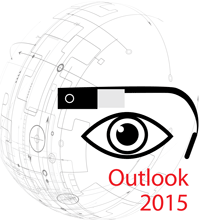
 What will the new year bring for the MICE industry in countries across Asia? TTGmice peeks into the future and discovers there is much for most of them to look forward to
What will the new year bring for the MICE industry in countries across Asia? TTGmice peeks into the future and discovers there is much for most of them to look forward to
